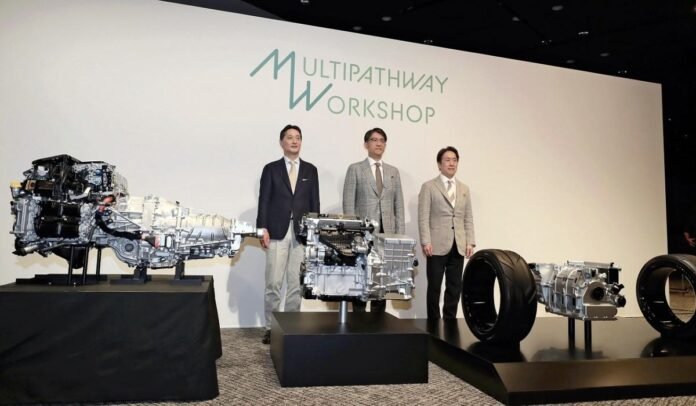From left to right, Subaru Corp. President Atsushi Osaki, Toyota Motor Corp. President Koji Sato and Mazda Motor Corp. President Masahiro Moro attend a press conference in Shibuya Ward, Tokyo, on Tuesday.
17:31 JST, May 29, 2024
Toyota Motor Corp.’s plan to develop new engines for its hybrid (HV) and plug-in hybrid (PHV) vehicles aims to increase the company’s competitiveness in the eco-friendly vehicle market by refining engine technology amid sluggish electric vehicle sales (EV).
Multipath strategy
The carmaker plans to develop two types of engines – a 1.5 liter and a 2 liter – with the aim of increasing power while making it 10% more compact.
By downsizing the engine, Toyota says it can improve fuel economy by 12% with the 1.5-liter engine, giving the automaker more freedom in designing a more aerodynamic body.
Toyota also anticipates that the new engines will be designed to run on carbon-neutral fuels that emit virtually no CO2. These include plant-based biofuels and e-fuel, which is made by synthesizing carbon dioxide and hydrogen.
While Toyota plans to increase global electric vehicle sales to 3.5 million units by 2030, it has also announced a multipath strategy to offer different types of electrified vehicles, including HVs and PHVs.
“We will develop engines optimized for the electrification era,” Toyota President Koji Sato said at a news conference in Tokyo on Tuesday.
Move at a similar pace
Mazda Motor Corp. and Subaru Corp., which have capital ties to Toyota, are also continuing at a similar pace to develop engines for the era of electrification.
Subaru is developing a new hybrid system using its unique horizontally opposed engine and plans to begin production of vehicles using the engine in fall 2024.
For its part, Mazda plans to develop a new vehicle using a rotary engine, which has been revived as a generator for PHVs.
While Toyota, Mazda and Subaru will each develop engines and other components separately, they will consider sharing information.
Taking care of parts suppliers
The three companies’ focus on engine development partly stems from their concerns about their affiliated parts suppliers.
Because EVs are estimated to require only about two-thirds of the parts used in gasoline vehicles, automakers are concerned that they won’t be able to keep their suppliers alive as the shift to EVs continues.
Demand for electric vehicles is slowing domestically, but they are expected to become increasingly widespread globally in the medium to long term.
Sato expressed his intention to work with auto parts suppliers to explore the future of electrified vehicles.
“We will change the future together and take responsibility for what kind of future we will create,” Sato said.
In response to the decarbonization trend, manufacturers such as Tesla Inc. from the United States and BYD Co. from China quickly appeared on the EV market.
However, EVs must solve problems such as high prices and a lack of infrastructure to charge vehicles. As a practical solution, HVs and PHVs, which are cheaper and have a longer driving range than EVs, are being reevaluated worldwide.
Meanwhile, Honda Motor Co. that by 2040, all its new vehicle sales will consist of EVs or fuel cell vehicles (FCV). The automaker has expanded sales in the North American market and says global sales of HVs could grow from the current 850,000. units per year to 1.8 million units per year.
Nissan Motor Co., which focuses on electric vehicles, also plans to launch a new PHV in the North American market.



